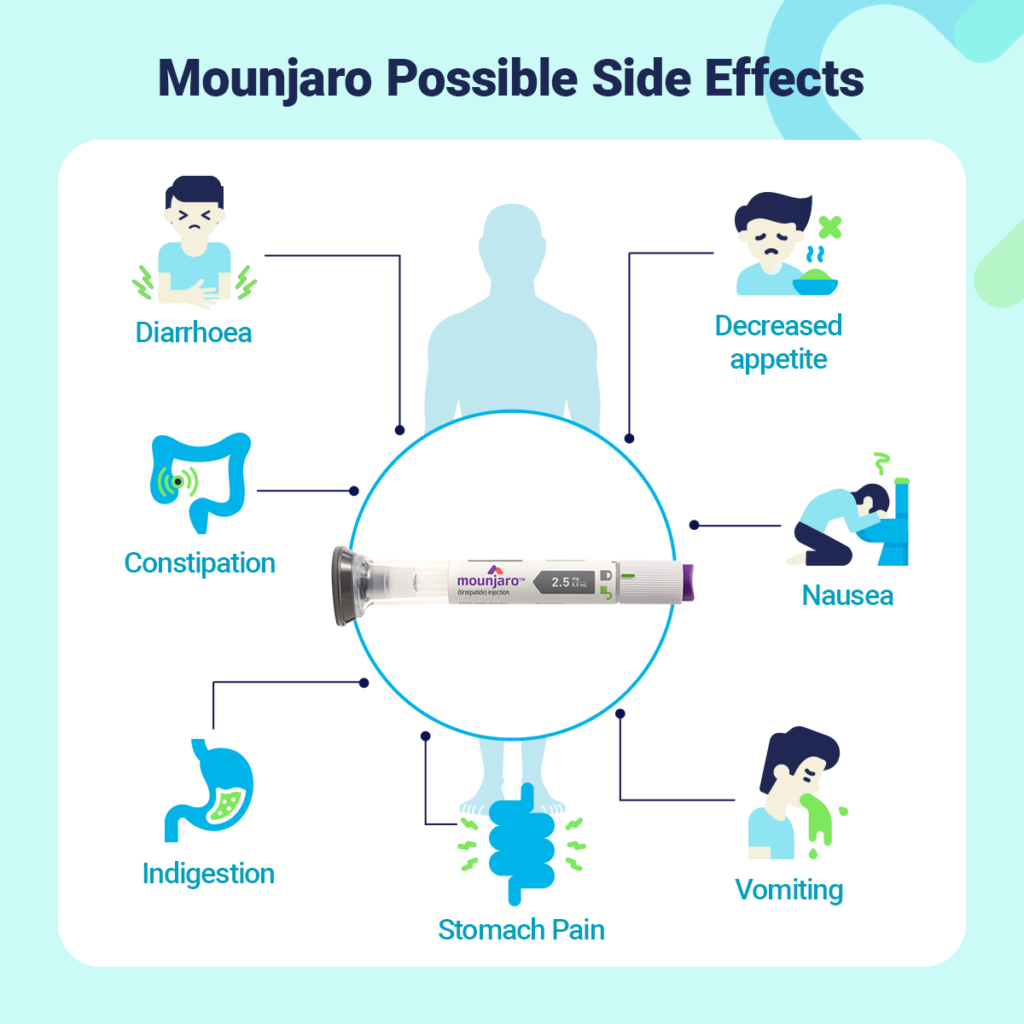Mounjaro is an injectable type 2 diabetes treatment that private clinics like myBMI provide for weight loss and weight management. Just like any other medication, it comes with a few potential side effects, so we have compiled a list of the most common side effects of Mounjaro and how you can manage and treat them.

What are the side effects of Mounjaro?
The most common side effects of Mounjaro are:
- Nausea
- Vomiting
- Diarrhoea
- Decreased appetite
- Constipation
- Indigestion and Acid Reflux
- Stomach pain
These side effects were reported by less than half of patients taking Mounjaro injections, and just over 3% of patients had to stop treatment due to side effects (which is a very small amount). We know that once you have started your weight loss journey you don’t want to give up – especially because of side effects. Here are some tips, tricks, and treatments for any Mounjaro side effects you may experience.
Dealing with nausea and vomiting from Mounjaro
Nausea is a word for feeling sick and vomiting is actually being sick. Nausea and vomiting tend to come hand-in-hand. A good way to handle this is by getting plenty of fresh air when you start feeling unwell. You should also take regular sips of water or a cold, still drink, and ensure that you’re eating smaller, but more frequent meals to avoid overfilling your belly. Try incorporating more dry foods like crackers or plain toast into your diet while feeling nauseous or vomiting.
Another good technique for handling nausea and vomiting is simply to distract yourself. Put your favourite film on or listen to your favourite music (but don’t dance too hard). After a while, you should hopefully begin to feel better!
So, take regular sips of cold fluids. Eat smaller amounts more frequently and distract yourself.
You could also try medication for nausea; anti-sickness tablets can help manage your symptoms if the self-help methods mentioned above are not effective in easing your Mounjaro side effects.
How long will nausea and vomiting last
Nausea should only last for a couple of days whilst your body gets used to the medication, and tends to occur as you increase the dose, but it may last for a few weeks. By using the techniques given above, it shouldn’t bother you too much. If it begins to trouble you or it becomes unbearable, you should speak to a medical professional.
Dealing with diarrhoea from Mounjaro
Diarrhoea is passing watery or more frequent stools, and it can be quite uncomfortable to deal with. It can cause belly pains, more nausea, and a loss of appetite. Again, drinking lots of water, juices, and broths can help. But try to avoid drinks like coffee, pure orange or apple juice, and alcohol as these can act as laxatives.
When you feel like your belly is starting to settle, try to eat some solid low-fibre foods like toast, crackers, or rice cakes.
Some over-the-counter medicines can also help when struggling with diarrhoea. Medicines such as Pepto-Bismol or loperamide can help ease diarrhoea.
How long will the diarrhoea last?
This side effect should only last for a few days. You’ll notice that your side effects subside as your body builds a tolerance to each dose. If you continue to experience diarrhoea for a prolonged period you must ensure that you maintain hydration and again, speak to a medical professional.
Dealing with decreased appetite from Mounjaro
Decreased appetite is a bitter-sweet side effect of Mounjaro. For weight-loss purposes, this is one of the main factors that helps you drop weight. A lower appetite means fewer calories which leads to weight loss. However, if you are using Mounjaro for type 2 diabetes, it may make it harder for you to eat vital meals during the day. Eating smaller meals more frequently or eating less food is fine as long as you are getting all the nutrients you need. Try to include something from each food group in your meals and you could use vitamin and mineral supplements to fulfil anything you missed.
How long until my appetite comes back?
The drug, tirzepatide, is made to make you feel fuller for longer and slow down your digestive system. As you increase your dose, your appetite will decrease. Your appetite will return when you stop using this treatment. Tirzepatide has a prolonged action so this may not be for 1-2 weeks after stopping.
Dealing with constipation from Mounjaro
Constipation is when you struggle to poo, and it can cause a lot of belly pain and trapped gas. One of the most effective ways of easing constipation is by eating high-fibre foods and foods that can have natural laxative effects, like beans, broccoli, or dried fruits.
If the constipation persists, you should speak to your doctor or pharmacist. Depending on your condition, they may recommend a stool softener type of laxative or a natural stimulant laxative, like senna tablets.
How long will the constipation last?
Hopefully following the above guidance should give you relief and you should get back to normal bowel movements in a couple of days. But, as mentioned before, persistent constipation should be discussed with a medical professional.
Dealing with indigestion and acid reflux from Mounjaro
Indigestion and acid reflux are common side effects of tirzepatide. Because it slows down the digestive system, it is normal to experience some discomfort.
Using ingredients like ginger, peppermint and apple cider vinegar in your foods can help ease indigestion. Antacid and acid reflux medications such as Gaviscon can help to neutralise excess stomach acid and relieve the irritation that causes these symptoms.
Indigestion tends to last from a few minutes to a few hours depending on how long it takes to process and fully digest your food.
Dealing with stomach pains from Mounjaro
Mild stomach pain may be experienced alongside nausea, indigestion and constipation. This should resolve after a few days of treatment as your body gets used to Mounjaro.
If you continue to have mild stomach pains there are a few types of medication you can take to ease the discomfort. Buscopan, Imodium and Gaviscon are great at relieving pain in the abdominal. General pain relief such as paracetamol will also help.
Severe stomach pain, sometimes accompanied by nausea, vomiting and acid reflux can be a sign of something more serious. If your pain does not resolve, please contact us or speak to your doctor.
You may experience these side effects while your body adjusts to Mounjaro. So after some time, the side effects should subside. But if you think that a lower dosage is the best option, it is always a good idea to consult a professional.
at myBMI we can offer free treatments for any side effects you may encounter, as part of your monthly plan, just bring up any concerns or queries during your next consultation.
We have some useful guides that explain what Mounjaro is and how tirzepatide works or you can start your consultation with one of our weight management specialists here:
















